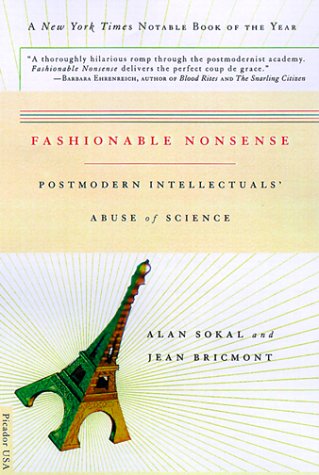 |
Here's the cover of the book that my book was not named after, but with which it has a peculiar resonance, not just in title but content. One essay in Fashionable Noise was inspired by Alan Sokal's infamous writing of a pseudo-scientific essay which he had published in a major journal sometime in the early nineties. Google it if you want to know more. This is a pretty good book, actually, if you are not too emotionally attached to Lacan or Kristeva. Ever since I coudn't convince my postcolonialism teacher that Chomsky thought more seriously about real world politics than Foucault (who I think looked pretty bad in that first interview in Power/Knowledge), and that, rather than being simply post-Marxists, it's worth discussing Muslim fundamentalism as a force for "resisting" the West and capitalism -- i.e. that the strength of the phenemonon needs accounting for even if we, as progressives, find the gender politics abhorrent -- I've tended to side with the less poetic, "rational" tradition of philosophers than those set on undercutting common sense at all turns for the sake of theory. Fashionable Nonsense might seem like a valiant effort by philistines to take the piss out of poststructuralism; in fact, since they start from their position as physicists and merely look at the use of metaphors and analogies in the works they are critiquing, it manages to preserve and highlight what is in fact useful and attractive about the works.

Our next line looks familiar, except it starts with an asterisk. Again, we're using the star operator, and noting that this variable we're working with is a pointer. If we didn't, the computer would try to put the results of the right hand side of this statement (which evaluates to 6) into the pointer, overriding the value we need in the pointer, which is an address. This way, the computer knows to put the data not in the pointer, but into the place the pointer points to, which is in the Heap. So after this line, our int is living happily in the Heap, storing a value of 6, and our pointer tells us where that data is living.
Posted by: Roland at January 19, 2004 02:47 AMOur next line looks familiar, except it starts with an asterisk. Again, we're using the star operator, and noting that this variable we're working with is a pointer. If we didn't, the computer would try to put the results of the right hand side of this statement (which evaluates to 6) into the pointer, overriding the value we need in the pointer, which is an address. This way, the computer knows to put the data not in the pointer, but into the place the pointer points to, which is in the Heap. So after this line, our int is living happily in the Heap, storing a value of 6, and our pointer tells us where that data is living.
Posted by: Mark at January 19, 2004 02:47 AMA variable leads a simple life, full of activity but quite short (measured in nanoseconds, usually). It all begins when the program finds a variable declaration, and a variable is born into the world of the executing program. There are two possible places where the variable might live, but we will venture into that a little later.
Posted by: Emmanuel at January 19, 2004 02:47 AMThis back and forth is an important concept to understand in C programming, especially on the Mac's RISC architecture. Almost every variable you work with can be represented in 32 bits of memory: thirty-two 1s and 0s define the data that a simple variable can hold. There are exceptions, like on the new 64-bit G5s and in the 128-bit world of AltiVec
Posted by: Gerrard at January 19, 2004 02:48 AM